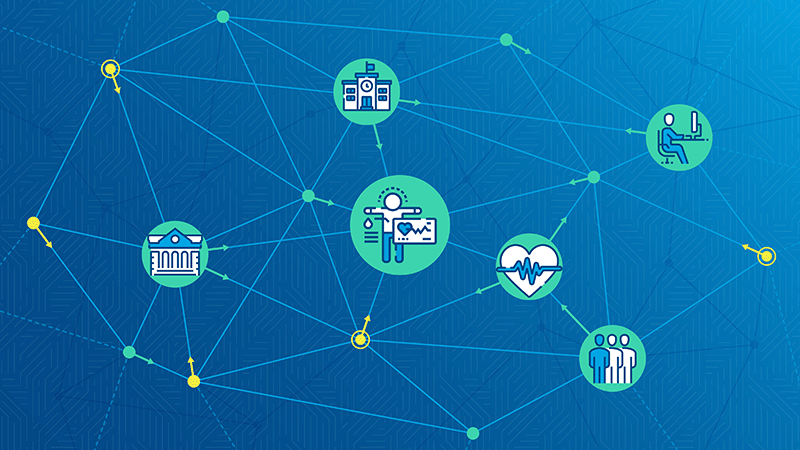 Summary
Summary
State agencies can’t solve complex challenges when their data is trapped in silos. This piece explores how interoperability and the right governance and automation tools help states meet compliance mandates, improve efficiency, and deliver more effective, whole-person care.
[Estimated read time 6 minutes]
Why state data interoperability matters for health and human services
Data silos in health and human services (HHS) aren’t simply technical obstacles, they’re barriers to delivering effective, whole-person care. When data is confined within individual programs or departments, agencies can’t access a clear picture of the interconnected factors that shape a person’s health and well-being.
Additionally, systems that don’t communicate force employees to duplicate efforts, creating inefficiencies in agencies already hampered by staffing shortages and budget constraints. When states break down these silos, they can eliminate redundant tasks, deliver more holistic care, and ultimately achieve long-term savings.
To realize this vision, states must prioritize improving how they share and govern data.
Fragmented systems impact citizens and states alike
Consider people who interact with multiple state programs. Without interoperability, each time a person engages with a state agency, their data splinters across systems that don’t communicate.
Conflicting governance and security rules between platforms make integration even harder. It’s frustrating for the citizen to start from scratch for every state service, and the disconnect can ripple into policy failures: missed interventions, wasted resources, and decisions made without a complete perspective.
Interoperability is now a compliance imperative
States will only be able to comply with the provisions of the recently passed One Big Beautiful Bill Act if they have robust, interoperable data systems. The legislation mandates:
- Rigorous cross-agency verification for Medicaid work requirements
- Thorough identity checks
- Six-month eligibility redeterminations
Simply put, it’s not possible to perform these actions dependably and in a timely manner without state data interoperability. Accurate information depends on seamless data sharing between Medicaid and agencies such as Public Health, Employment, and Education.
States that fail to use data matching to prevent improper payments risk financial penalties, making effective data integration critical to both compliance and funding.
Begin with cross-agency collaboration
While resolving HHS data silos is complex, many modern solutions can connect systems with far less expense and risk than in years past. The key to making meaningful strides toward the goal is for states to adopt a strategic, phased approach that addresses data governance and data interoperability.
The first and most critical step is to formalize a cross-agency data governance structure.
Each department in state government owns and wants to protect its own data, often due to regulatory concerns or differing privacy standards. Additionally, agencies may use different IT systems, data formats, coding standards, and legacy systems which can limit interoperability.
The only way to promote shared responsibility and sustainable governance of data resources across state government is inter-agency collaboration. Representatives from key agencies such as Medicaid, human services, education, workforce, and housing must collaborate to create unified data use agreements, standardize data definitions, and implement data quality standards to facilitate interoperability.
Don’t replace systems, enhance them
Once a strong governance foundation is in place, states should prioritize targeted projects that improve how systems communicate.
Instead of replacing large, complex systems that can be costly and time intensive, states can enhance their existing infrastructure with intelligent automation for data interoperability.
Technologies such as Resultant’s Scalable Probabilistic Record Linkage provide a practical, secure way to unify person-level data without requiring identical identifiers or major system changes. Using fuzzy matching, hashing, and similarity scoring, it links records even when information like names and addresses are incomplete or inconsistent.
Robotic process automation (RPA) can help agencies further enhance interoperability. By automating repetitive, rules-based data tasks and securely transferring, validating, and updating records across disparate systems, RPA reduces manual workload and ensures more accurate, timely data flows between programs.
Technologies like these enable states to resolve fragmented identities and improve data consistency. Creating a more complete view of individuals interacting with multiple programs helps agencies more quickly verify eligibility, reduce duplication, and deliver coordinated, whole-person care.
Conclusion: Why interoperability is a smart investment for states
As states continue to enhance data interoperability, agencies will be better equipped to use data strategically to actively improve public health outcomes, human services, and costs to taxpayers. Integrated data enables earlier interventions, transparency between agencies, and more targeted resource allocation.
At a time when agencies face significant staff shortages and constrained budgets, interoperability allows existing teams to work more efficiently and meet the requirements of the One Big Beautiful Bill while avoiding or reducing penalties. Interoperability is a strategic investment in more effective services and long-term fiscal sustainability. Executing it in a thoughtful, phased approach takes the bite out of both the risk and the cost.
Not sure where to start with interoperability?
Read our whitepaper primer on data modernization here.
Share:







